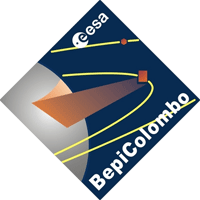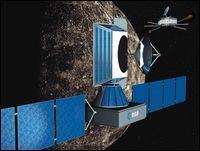 Mission objectives
Mission objectives
- Origin and evolution of a planet close to the parent star
- Mercury as a planet: form, interior structure, geology, composition and craters
- Origin of Mercury's magnetic field
- Mercury's vestigial atmosphere (exosphere): composition and dynamics
- Mercury's magnetized envelope (magnetosphere): structure and dynamics
- Test of Einstein's theory of general relativity
About Project
BepiColombo, an ESA mission in cooperation with Japan, will explore Mercury, the planet closest to the Sun. Europe's space scientists have identified the mission as one of the most challenging long-term planetary projects, largely because Mercury's orbit so close to the Sun makes the planet difficult for a spacecraft to reach and difficult to observe from a distance.
Scientists want to study Mercury because of the valuable clues it will provide in understanding how planets form.
BepiColombo is named after Professor Giuseppe (Bepi) Colombo (1920-1984) from the University of Padua, Italy, a mathematician and engineer of astonishing imagination.
He was the first to see that an unsuspected resonance is responsible for Mercury's habit of rotating on its axis three times for every two revolutions it makes around the Sun. He also suggested to NASA how to use a gravity-assist swing-by of Venus to place the Mariner 10 spacecraft in a solar orbit that would allow it to fly by Mercury three times in 1974-5.
With two spacecraft, BepiColombo is a large and costly mission, one of the 'cornerstones' in ESA's long-term science programme. The mission presents enormous, but exciting challenges. All of ESA's previous inter-planetary missions have been to relatively cold parts of the Solar System. BepiColombo will be the Agency's first experience of sending spacecraft to "hot" regions.
About Mercury
 Mercury is a small planet, not much bigger than our Moon. Of the nine planets orbiting the Sun, only Pluto is smaller. Although Mercury has been known since Egyptian times, it remains a mystery.
Mercury is a small planet, not much bigger than our Moon. Of the nine planets orbiting the Sun, only Pluto is smaller. Although Mercury has been known since Egyptian times, it remains a mystery.
Mercury's surface, heavily scarred with craters and plains of frozen lava, looks similar to the Moon. The most striking feature is the Caloris Basin, a huge impact crater that is matched on the opposite side of the planet by hilly, fractured terrain. Scientists suspect that the shock wave from the impact may have travelled through the planet to cause fracturing of the crust into giant blocks on the other side. On Earth, this would be similar to an impact occurring in Europe reaching through to the South Pacific and leaving its mark there.
Mercury takes only 88 Earth days to complete one orbit, but it rotates slowly about its own axis, only once every 59 Earth days. This means that it rotates precisely three times for every two orbits, known as a 3:2 orbital resonance. Once every two Hermean years therefore, the same side of the planet faces the Sun. Mercury is the only body in the Solar System known to have such a resonance with its parent body.
Scientific instruments
The mission will consist of two separate spacecraft that will orbit the planet. ESA is building one of the main spacecraft, the Mercury Planetary Orbiter (MPO), and the Japanese space agency ISAS/JAXA will contribute the other, the Mercury Magnetospheric Orbiter (MMO).
The MPO will study the surface and internal composition of the planet. The instruments on this orbiter will consist of two cameras for high-resolution imaging and a suite of spectrometers for observing the radiation emitted by the surface of the planet in the infrared, ultraviolet, X-rays, gamma-rays and neutrons.
The spectra recorded will reveal the minerals and elements in the surface, the presence of water ice beneath the surface, and the constituents of Mercury's thin atmosphere. The MPO will also carry a laser altimeter for measuring the morphology of Mercury's surface, and two radio science experiments for measuring the distribution of mass within the planet.
MMO will study Mercury's magnetosphere, that is the region of space around the planet that is dominated by its magnetic field. It will carry detectors to observe Mercury's magnetic field and its interactions with the solar wind.
Launch in 2018
 BepiColombo has started in October 2018 its journey lasting up to seven years. It was launched on Ariane 5 rocket from Europe's Spaceport in French Guiana. Launch mass of both satellites with Mercury Transer Module (MTM) was about 2300 kg. When it arrives at Mercury in late 2025, it will endure temperatures as high as 250°C to bring us new images and data about the least explored planet in the inner Solar System. Observations from orbit will continue for one Earth year from January 2026 until January 2027, with a possible 1-year extension to January 2028.
BepiColombo has started in October 2018 its journey lasting up to seven years. It was launched on Ariane 5 rocket from Europe's Spaceport in French Guiana. Launch mass of both satellites with Mercury Transer Module (MTM) was about 2300 kg. When it arrives at Mercury in late 2025, it will endure temperatures as high as 250°C to bring us new images and data about the least explored planet in the inner Solar System. Observations from orbit will continue for one Earth year from January 2026 until January 2027, with a possible 1-year extension to January 2028.
The spacecraft must brake against the Sun's gravity, which increases with proximity to the Sun, rather than accelerate away from it, as is the case with journeys to the outer Solar System. When approaching Mercury, each spacecraft will use the planet's gravity plus a conventional rocket engine to insert itself into a polar orbit.